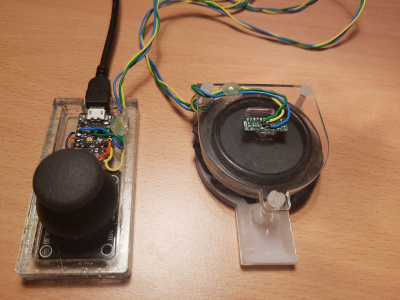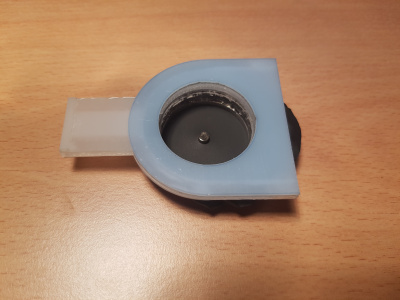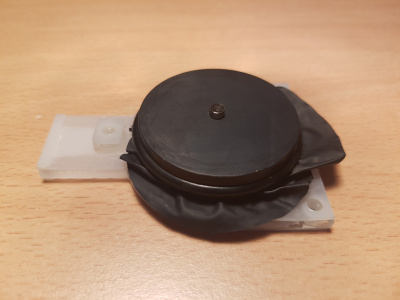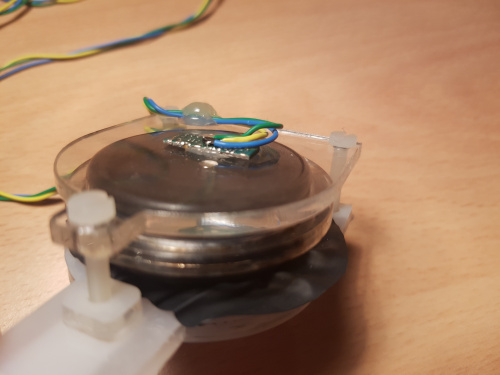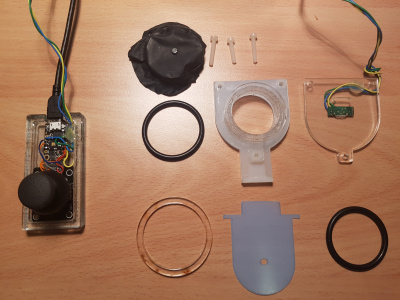Inhaltsverzeichnis
Features
- Breath controller
- Send control change messages via Midi to DAW (CC2 breath control)
- Fast and responsive (200 Hz CC2 update rate)
- Easy to clean and easy to dry - pressure sensor can be opened via a slide
- Based on a linear Hall-sensor and two magnets on a membrane cut out of a rubber glove
- X/Y Joystick
- Sends 4 additional CCs
- Optical metronome
- Uses internal RGB LED
- Indicates Beat 1, 2, 3, 4 of optically (no annoying click-sound)
- Easy to use with Ableton Live - just activate "Sync" on Midi-Out in Preferences
- Alternative control of RGB via note velocity (send notes C, D, E to device, velocity = brightness)
- Full DIY
- Based on Adafruit Trinket M0
- All parts laser cut from 0.5 and 4mm acrylics
- No hard-to-get special pressure sensor
Breath controller
Background
To play wind instruments more realistic if you are a keyboard player, a breath-controller is a good option: You select the notes to play with your keyboard, but the sound is triggered and articulated based on your breath. This is not only useful for flute-like instruments, but also for other instruments like brass and strings that can articulate a note more then just on-off.
Cleaning
A major issue with many (commercially) breath controllers is the cleaning of the device. As moisture from breath accumulates fast, I wanted a breath controller that can be cleaned and dried easily - even the pressure sensor itself. My design avoids tubing and by removing a slider, the inner parts of the pressure sensor is accessible for easy cleaning and drying. If you remove the top plate with the hall-sensor everything can be rinsed under water.
The membrane consists of a circular patch cut from a rubber glove (I used a black Nitril glove). A small magnet is placed on top of the membrane and fixed using another magnet on the opposite side. The membrane is held in place using a rubber O-Ring and a press-fit acrylic ring on top - so the membrane can be easily replaced without any gluing.
Calibration
The software uses an automatic calibration of the base-line every time no pressure is detected. So even after replacing the membrane you usually don't have to re-calibrate the device manually. On the first setup you have to define by a single number the sensitivity of your setup (mainly dependent on you hall sensor, magnets and distance magnet vs hall-sensor) so that the maximum blow (where usually the membrane magnet hits the top acrylic plate) outputs a CC value of up to 127.
Instruments
If you own Native Instruments Reaktor, I like to recommend the free community instruments especially the "Silverwood" ones from Chef Singer. Silverwood Flute, Silverwood Clarinets as well as Silverwood Tenor Sax are very good sounding instruments as they are using pysical models to synthesize those instruments. Don't forget to add a little reverb to make them sound really great.
Also other sample-based instruments, especially strings but also organs, can be articulated much nicer using a breath-controller. Often expression (CC11) or breath control (CC2) is supported - so find out. You can change the Arduino code to use CC11 instead of CC2 if you like, I prefer a little M4L device to clone CC2 to CC11 for this purpose...
How it is build
Usually people (like me) use instructions like this only for own inspirations, so this is not meant to be a full "how-to-build" instruction, but it should give you enough insights to do so if you want. In the rare case you really build this and make it to work please drop us a mail :-)
All parts are laser-cut from a very thin (0.5mm) like acrylic sheet and a thicker (4mm) acrylic plate. The 0.5mm acrylic is more like a foil and much more flexible than the 4mm glass like sheets. These are the files with the laser cut parts made with Inkscape:
- Datei:MembranBreathConttrolThinPlexi.svg for thin (0.5mm) acrylic
- Datei:MembranBreathConttrolThickPlexi.svg for thick (4mm) acrylic
All parts are laser cut and glued with acrylic glue.
- MembraneBreathCtrl assembly
